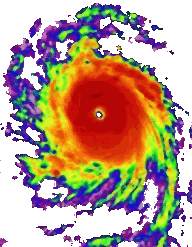HURRICANE
The name, hurricane, is from the Carib god, Huarakan.

If you live in Florida chances are you know what a hurricane is, but in case you don't.......
Hurricane's are cyclones over water while tornadoes are cyclones over land. A hurricane is a tropical cyclone in which the maximum sustained surface winds are 74 miles per hour or greater. Hurricanes have circling bands consisting of severe winds, heavy rain and lightning rotating in a counterclockwise direction around a relatively calm center of extremely low atmospheric pressure known as the Hurricane's Eye.
Hurricane season runs from June 1 to November 30 each year. Floridians listen to weather warnings to decide when to put up shutters or evacuate. A "Tropical Storm Watch" is when a threat to a coastal area can occur within the next 36 hours. A "Tropical Storm Warning" is a storm expected within 24 hours with winds of 39-73 miles per hour. A Hurricane Watch is winds exceeding hurricane strength expected within 36 hours. A "Hurricane Warning" is issued within 24 hours or less, of winds exceeding 74 miles per hour.